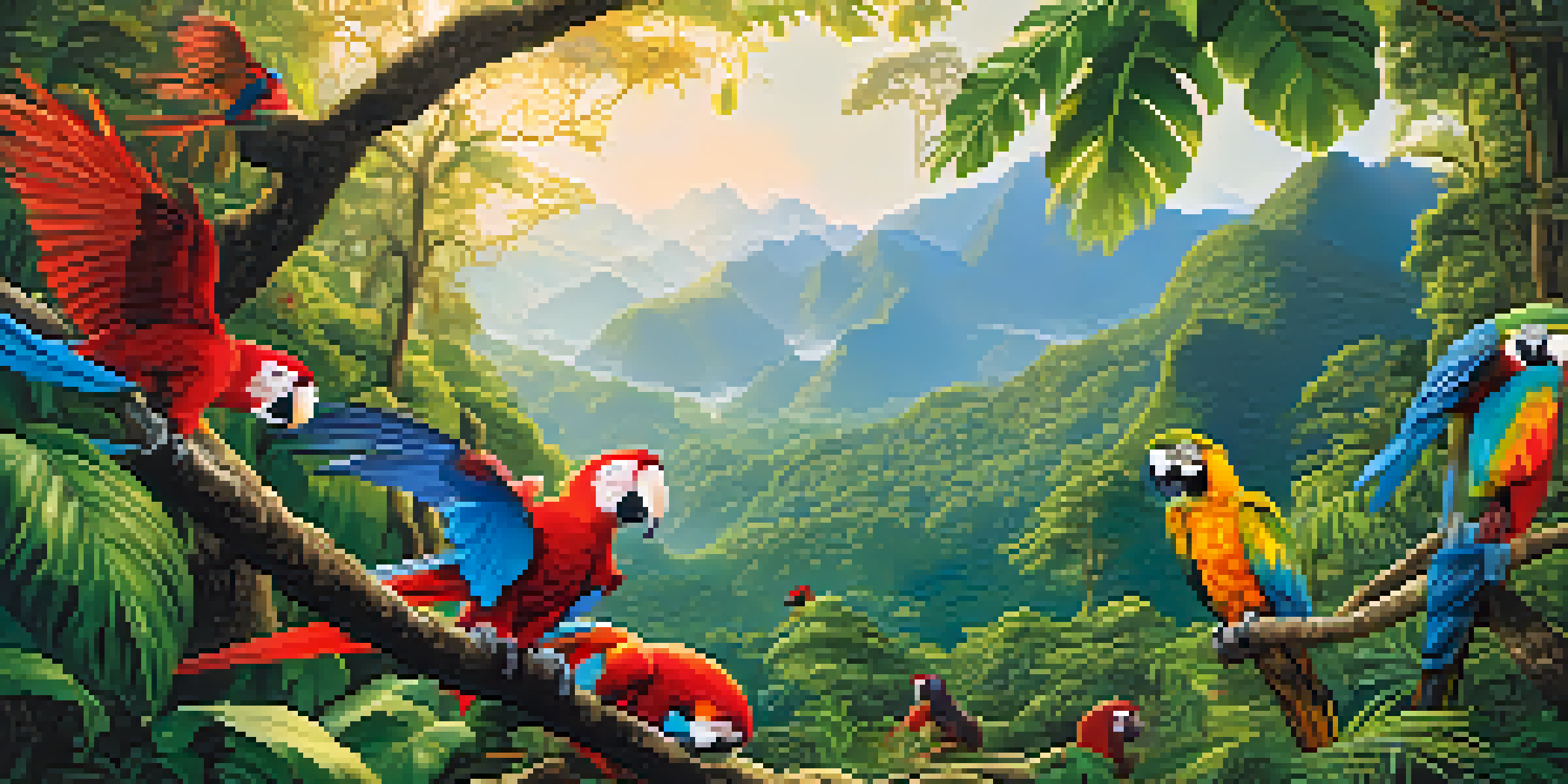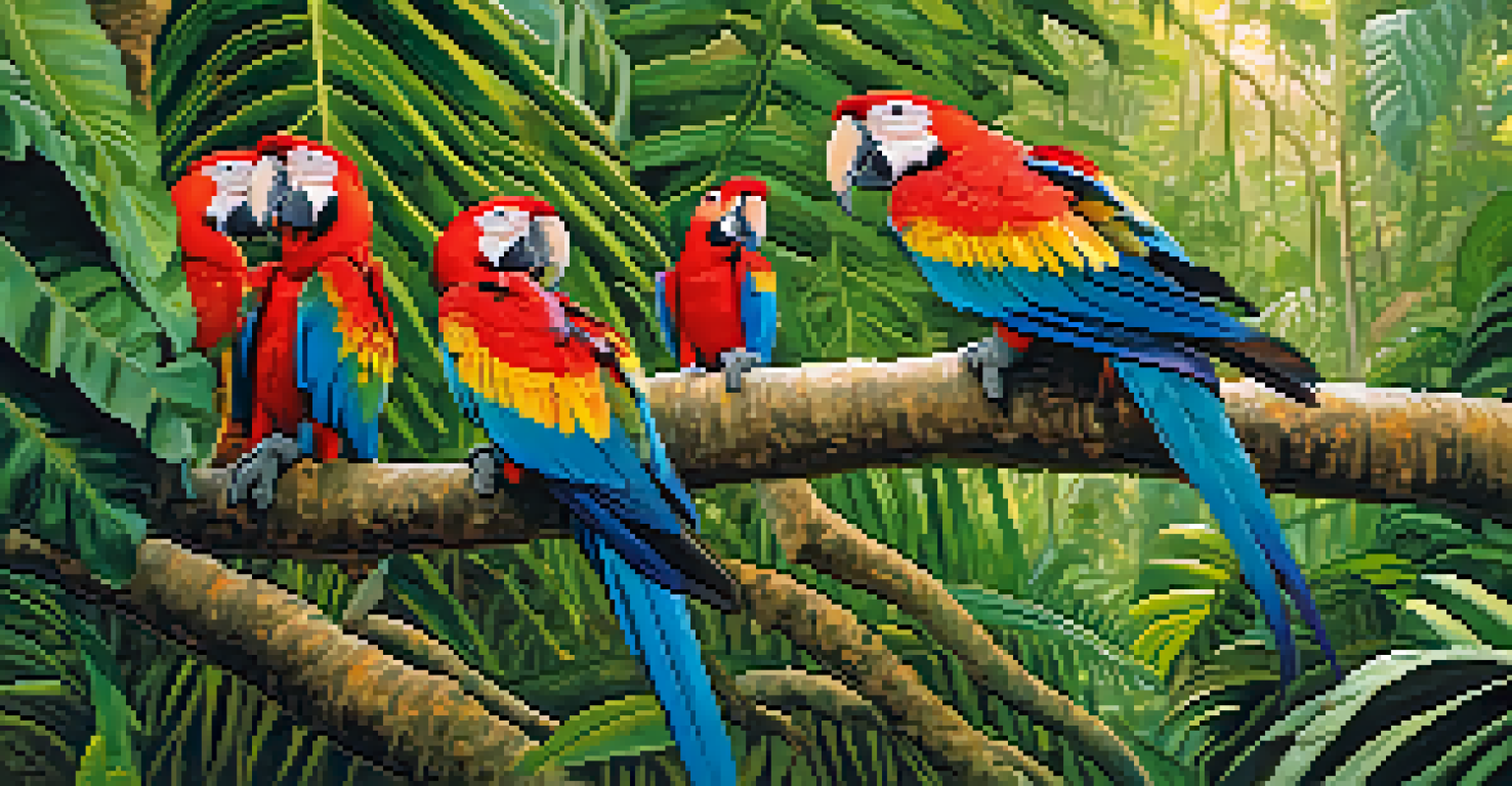Birdwatching in Peru: Guided Nature Walks for Enthusiasts

Discover Peru's Birdwatching Paradise
Peru is a birdwatcher's dream, boasting over 1,800 species, including the vibrant Scarlet Macaw and the elusive Andean Condor. With diverse ecosystems ranging from the Amazon rainforest to the Andes mountains, the country offers a rich tapestry of habitats. Whether you’re a seasoned birder or just starting out, Peru’s avian diversity is sure to captivate your imagination.
In every walk with nature one receives far more than he seeks.
Regions like Manu National Park and the Tambopata Reserve are particularly famous for their bird populations. These areas not only provide stunning views but also a chance to see rare species in their natural habitats. Imagine walking through lush greenery, accompanied by the sounds of exotic birds calling from the treetops—it's an experience like no other!
Guided nature walks enhance this adventure, offering insights from experienced local guides who know the best spots to observe these magnificent creatures. They can help you identify different species and share fascinating facts about their behavior and habitats. This combination of knowledge and nature makes birdwatching in Peru a fulfilling experience.
The Benefits of Guided Nature Walks
Choosing a guided nature walk can significantly enhance your birdwatching experience. Guides are not only familiar with the area’s flora and fauna but also have a knack for spotting birds that might escape the untrained eye. Their expertise can transform a casual outing into an educational adventure, making it easier to connect with nature.

Guided tours often cater to different skill levels, ensuring that both beginners and expert birders feel comfortable and engaged. For instance, a novice might enjoy learning about basic bird identification techniques, while a more experienced birder can delve into the complexities of avian behavior. This tailored approach makes the experience enjoyable for everyone.
Explore Peru's Birdwatching Hotspots
Peru is home to incredible birdwatching locations like Manu National Park and the Tambopata Reserve, showcasing a stunning variety of avian species.
Moreover, guided walks often include access to remote locations that are less frequented by tourists. These hidden gems can provide a more intimate and rewarding birdwatching experience. Imagine standing in silence as a rare bird flits by, an opportunity made possible by the local guide's knowledge of the best spots.
Top Birdwatching Locations in Peru
When it comes to birdwatching, some locations in Peru stand out for their exceptional diversity. Manu National Park is often hailed as one of the best spots, where you can encounter an astonishing array of species within a single day. The park's unique blend of ecosystems—from lowland rainforests to high-altitude grasslands—creates a haven for birds.
Birds are indicators of the environment. If they are in trouble, we know we’ll soon be in trouble.
Another must-visit is the Tambopata National Reserve, known for its rich biodiversity and stunning landscapes. The reserve is home to the famous Collpa de Guacamayos, where colorful macaws gather to feed on clay. This sight is a highlight for many birdwatchers and a fantastic photo opportunity.
Don't overlook places like the Oxapampa-Asháninka-Yánesha Biosphere Reserve, where you can find numerous endemic species. Each of these locations offers unique experiences, allowing you to witness the incredible range of avian life that Peru has to offer.
Essential Gear for Birdwatching
Having the right gear can make a significant difference in your birdwatching experience. A good pair of binoculars is essential for observing birds without disturbing them; look for a model with a wide field of view and high magnification. This way, you can spot even the smallest details of each bird you encounter.
Additionally, a field guide specific to Peruvian birds can be an invaluable resource. It can help you identify species you see in the field and learn more about their characteristics. Many guides also include beautiful illustrations, making them enjoyable to browse even when you're not out birdwatching.
Enhance Your Experience with Guides
Guided nature walks provide valuable insights and access to remote locations, making birdwatching more enriching and enjoyable for all skill levels.
Comfortable clothing and sturdy footwear are also important, especially if you’re hiking through varied terrain. Consider wearing layers to adapt to changing weather conditions, and don’t forget essentials like sunscreen and insect repellent. Being prepared ensures you can focus on the joy of birdwatching without distractions.
Respecting Nature and Wildlife
While enjoying the beauty of Peru's birds, it's crucial to practice responsible birdwatching. Respecting wildlife means minimizing disturbances to their natural habitats. Stay on designated trails, keep noise levels down, and maintain a respectful distance from nesting sites or feeding areas.
Engaging with local communities can also enhance your experience while promoting sustainable practices. Many communities offer birdwatching tours that benefit both the environment and local economies. By choosing these tours, you’re helping to preserve the delicate ecosystems that support these beautiful birds.
Moreover, consider participating in conservation efforts or educational programs during your visit. These initiatives often provide valuable insights into the challenges birds face and how you can help protect them. Taking an active role fosters a deeper connection with nature and contributes to its preservation for future generations.
Best Times for Birdwatching in Peru
Timing can significantly impact your birdwatching experience in Peru. Generally, the dry season from May to September is ideal for spotting a wide variety of species, as birds are often more active and easier to observe. This period also tends to have more stable weather, making excursions more enjoyable.
However, the wet season from October to April presents its own unique opportunities. Many migratory birds return during this time, and the lush landscapes create vibrant backdrops for your adventures. Plus, the rain can bring out different species that are less active in drier conditions.
Plan for the Best Birdwatching Times
Understanding the timing, particularly the dry and wet seasons, can significantly enhance your birdwatching experience in Peru.
Ultimately, the best time for you might depend on the specific species you're eager to see. Researching migratory patterns and local bird activity can help you plan your trip around peak viewing times. Whether you visit during the dry or wet season, Peru promises unforgettable birdwatching opportunities.
Planning Your Birdwatching Trip
Planning a birdwatching trip in Peru requires some thoughtful preparation. Start by choosing the regions that interest you most, whether it's the Amazon, the Andes, or coastal areas. Researching local guides and tour companies can help you find the right fit for your experience level and interests.
Consider the logistics, such as transportation and accommodations, especially in remote areas. Booking in advance can secure your spot in popular guided tours and help you avoid last-minute hassles. Additionally, having a flexible itinerary allows for spontaneous birdwatching opportunities that may arise.

Lastly, remember that birdwatching is as much about the journey as it is about the destination. Embrace the beauty of Peru's landscapes and immerse yourself in the experience. Every moment spent in nature is a chance to learn and grow, making your trip truly memorable.